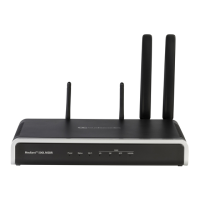User's Manual 67. Configuration Parameters Reference
Version 6.8 1015 Mediant 500L MSBR
Parameter Description
[SBCExtensionsProvisioningM
ode]
Enables SBC user registration for interoperability with BroadSoft's
BroadWorks server, to provide call survivability in case of
connectivity failure with the BroadWorks server.
[0] = (Default) Normal processing of REGISTER messages.
[1] = Registration method for BroadWorks server. In a failure
scenario with BroadWorks, the device acts as a backup SIP
proxy server, maintaining call continuity between the
enterprise LAN users (subscribers) and between the
subscribers and the PSTN (if provided).
Note: For a detailed description of this feature, see ''Auto-
Provisioning of Subscriber-Specific Information for BroadWorks
Server'' on page 535.
Web: SBC Direct Media
CLI: sbc-direct-media
[SBCDirectMedia]
Enables the No Media Anchoring feature (i.e., direct media) for all
SBC calls, whereby SIP signaling is handled by the device
without handling the RTP/SRTP (media) flow between the user
agents (UA). The RTP packets do not traverse the device.
Instead, the two SIP UAs establish a direct RTP/SRTP flow
between one another. Signaling continues to traverse the device
with minimal intermediation and involvement to enable certain
SBC abilities such as routing
[0] Disable = (Default) All calls traverse the device (i.e., no
direct media). If No Media Anchoring is enabled for an SRD (in
the SRD table), then calls between endpoints belonging to that
SRD use No Media Anchoring.
[1] Enable = All SBC calls use the No Media Anchoring
feature (i.e., direct media).
Note: For more information on No Media Anchoring, see ''No
Media Anchoring (Anti Tromboning)'' on page 522.
SBC RTCP Mode
CLI: sbc-rtcp-mode
[SBCRTCPMode]
Global parameter that defines the handling of RTCP packets. You
can also configure this functionality per specific calls, using IP
Profiles (IPProfile_SBCRTCPMode). For a detailed description of
this parameter and for configuring this functionality in the IP
Profile table, see ''Configuring IP Profiles'' on page
332.
Note: If this functionality is configured for a specific IP Profile, the
settings of this global parameter is ignored for calls associated
with the IP Profile.
Web: SBC Send Invite To All
Contacts
CLI: sbc-send-invite-to-all-
contacts
[SBCSendInviteToAllContacts]
Enables call forking of INVITE message received with a Request-
URI of a specific contact registered in the device's database, to all
users under the same AOR as the contact.
[0] Disable (default) = Sends the INVITE only to the contact of
the received Request-URI.
[1] Enable
To configure call forking initiated by the device, see ''Initiating SIP
Call Forking'' on page 540.
Web: SBC Shared Line
Registration Mode
CLI: sbc-shared-line-reg-mode
[SBCSharedLineRegMode]
Enables the termination on the device of SIP REGISTER
messages from secondary lines that belong to the Shared Line
feature.
[0] Disable = (Default) Device forwards the REGISTER
messages as is (i.e., not terminated on the device).
[1] Enable = REGISTER messages of secondary lines are
terminated on the device.
Note: The device always forwards REGISTER messages of the

